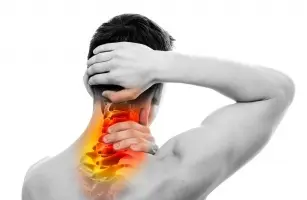Contents

Degeneration of the cervical spine usually affects people over the age of fifty. However, this is not the rule. Sometimes under the influence of a strong external stimulus, such as a road collision or a traffic accident, the cervical spine is damaged in much younger people. The causes of the disease can also be: posture defects, long-term, long-term staying in an inappropriate position, e.g. in office work or at the production line, and even sleeping on the wrong shape of the pillow. Degenerative changes may be small, but if diagnosed late and untreated, they can lead to very serious consequences.
The most common symptoms of cervical spine degeneration are:
- headache and neck pain,
- feeling of stiffness in the neck,
- visual and hearing disorders,
- paresis, hand numbness,
- sensory disturbances in the arms and legs,
- dizziness, nausea, vomiting, tinnitus with no apparent other cause.
- sometimes symptoms typical of heart or brain diseases.
Structure of the cervical spine:
Neck spine – consists of 7 cervical vertebrae, in the shape of a slightly tilted forward arc. These vertebrae are the smallest and most movable of all our vertebrae and allow you to move your head in different directions. This part of the spine is a kind of mechanical bracket connecting the head with the chest. It is an extremely delicate structure, susceptible to various types of injuries. In individual cervical vertebrae there are narrow openings through which the most important nerves responsible for human senses run. The middle vertebrae are most susceptible to degeneration cervical spine, and more specifically those from 3 to 6.
When we observe the symptoms of degeneration cervical spine and we suspect that we are dealing with this particular condition, we must immediately seek medical advice. Changes in the cervical spine can be confirmed by X-ray examination, or, if necessary, magnetic resonance imaging or computed tomography.
Way of treatment:
- Putting on a sponge orthopedic collar – for relative immobilization of the cervical spine. After its application, the performance of movements is much more difficult, thanks to which the affected area is stabilized, and this prevents further progression of the disease. The collar is put on for a few days, after which the effects of its operation are monitored.
- Pharmacological treatment – symptomatic treatment is used, with analgesics, non-steroidal anti-inflammatory drugs and reducing excessive muscle tension.
- Physical treatments, such as physiotherapy, rehabilitation – used to maintain the efficiency of the spine and muscles.
- Appropriate posture of the patient – a very important element is not to eliminate the effects of treatment yourself. The sick spine should be relieved, the correct body posture should be maintained, especially when lying down, sudden movements should be avoided, and the recommended exercises should be performed regularly and conscientiously.









